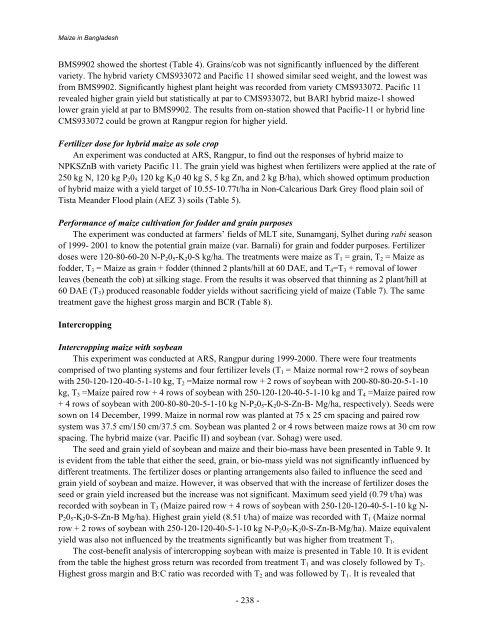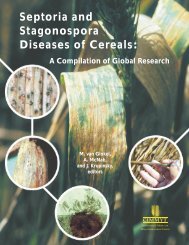Section 3 (Crop Management)
Section 3 (Crop Management)
Section 3 (Crop Management)
Create successful ePaper yourself
Turn your PDF publications into a flip-book with our unique Google optimized e-Paper software.
Maize in Bangladesh<br />
BMS9902 showed the shortest (Table 4). Grains/cob was not significantly influenced by the different<br />
variety. The hybrid variety CMS933072 and Pacific 11 showed similar seed weight, and the lowest was<br />
from BMS9902. Significantly highest plant height was recorded from variety CMS933072. Pacific 11<br />
revealed higher grain yield but statistically at par to CMS933072, but BARI hybrid maize-1 showed<br />
lower grain yield at par to BMS9902. The results from on-station showed that Pacific-11 or hybrid line<br />
CMS933072 could be grown at Rangpur region for higher yield.<br />
Fertilizer dose for hybrid maize as sole crop<br />
An experiment was conducted at ARS, Rangpur, to find out the responses of hybrid maize to<br />
NPKSZnB with variety Pacific 11. The grain yield was highest when fertilizers were applied at the rate of<br />
250 kg N, 120 kg P205 120 kg K20 40 kg S, 5 kg Zn, and 2 kg B/ha), which showed optimum production<br />
of hybrid maize with a yield target of 10.55-10.77t/ha in Non-Calcarious Dark Grey flood plain soil of<br />
Tista Meander Flood plain (AEZ 3) soils (Table 5).<br />
Performance of maize cultivation for fodder and grain purposes<br />
The experiment was conducted at farmers’ fields of MLT site, Sunamganj, Sylhet during rabi season<br />
of 1999- 2001 to know the potential grain maize (var. Barnali) for grain and fodder purposes. Fertilizer<br />
doses were 120-80-60-20 N-P205-K20-S kg/ha. The treatments were maize as T1 = grain, T2 = Maize as<br />
fodder, T3 = Maize as grain + fodder (thinned 2 plants/hill at 60 DAE, and T4=T3 + removal of lower<br />
leaves (beneath the cob) at silking stage. From the results it was observed that thinning as 2 plant/hill at<br />
60 DAE (T3) produced reasonable fodder yields without sacrificing yield of maize (Table 7). The same<br />
treatment gave the highest gross margin and BCR (Table 8).<br />
Intercropping<br />
Intercropping maize with soybean<br />
This experiment was conducted at ARS, Rangpur during 1999-2000. There were four treatments<br />
comprised of two planting systems and four fertilizer levels (T1 = Maize normal row+2 rows of soybean<br />
with 250-120-120-40-5-1-10 kg, T2 =Maize normal row + 2 rows of soybean with 200-80-80-20-5-1-10<br />
kg, T3 =Maize paired row + 4 rows of soybean with 250-120-120-40-5-1-10 kg and T4 =Maize paired row<br />
+ 4 rows of soybean with 200-80-80-20-5-1-10 kg N-P205-K20-S-Zn-B- Mg/ha, respectively). Seeds were<br />
sown on 14 December, 1999. Maize in normal row was planted at 75 x 25 cm spacing and paired row<br />
system was 37.5 cm/150 cm/37.5 cm. Soybean was planted 2 or 4 rows between maize rows at 30 cm row<br />
spacing. The hybrid maize (var. Pacific II) and soybean (var. Sohag) were used.<br />
The seed and grain yield of soybean and maize and their bio-mass have been presented in Table 9. It<br />
is evident from the table that either the seed, grain, or bio-mass yield was not significantly influenced by<br />
different treatments. The fertilizer doses or planting arrangements also failed to influence the seed and<br />
grain yield of soybean and maize. However, it was observed that with the increase of fertilizer doses the<br />
seed or grain yield increased but the increase was not significant. Maximum seed yield (0.79 t/ha) was<br />
recorded with soybean in T3 (Maize paired row + 4 rows of soybean with 250-120-120-40-5-1-10 kg N-<br />
P205-K20-S-Zn-B Mg/ha). Highest grain yield (8.51 t/ha) of maize was recorded with T1 (Maize normal<br />
row + 2 rows of soybean with 250-120-120-40-5-1-10 kg N-P205-K20-S-Zn-B-Mg/ha). Maize equivalent<br />
yield was also not influenced by the treatments significantly but was higher from treatment T1.<br />
The cost-benefit analysis of intercropping soybean with maize is presented in Table 10. It is evident<br />
from the table the highest gross return was recorded from treatment T1 and was closely followed by T2.<br />
Highest gross margin and B:C ratio was recorded with T2 and was followed by T1. It is revealed that<br />
- 238 -









